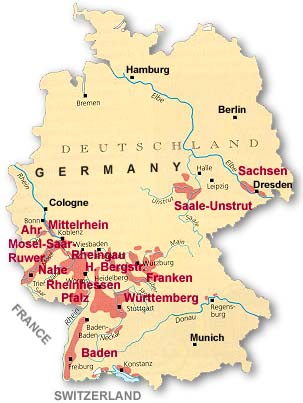Difference between revisions of "German Wine"
From Eric's Brain
(→German wine growing regions) |
(→German wine growing regions) |
||
| Line 18: | Line 18: | ||
== German wine growing regions == | == German wine growing regions == | ||
<html> | <html> | ||
| − | < | + | <img src="/images/german_wine_regions.jpg" height="403" width="303" border="0" usemap="#regions" style="display: block; margin-left: auto; margin-right: auto;"> |
<map name="regions"> | <map name="regions"> | ||
<area shape="rect" coords="51,292,94,306" onClick="alert('Pfaltz');" nohref alt="Pfalz"> | <area shape="rect" coords="51,292,94,306" onClick="alert('Pfaltz');" nohref alt="Pfalz"> | ||
Revision as of 20:06, 31 March 2015
German wine overview
German vineyards are most well known for their white grape varieties:
- Riesling
- Müller-Thurgau (Rivaner)
- Silvaner (Sylvaner)
- Pinot Gris (Grauburgunder or Ruländer)
- Pino Blanc (Weissburgunder)
- Gewürtztraminer.
red wines are available, but are generally not as widely available as white wines:
- Pino Noir (Spätburgunder)
- Trollinger (Blauer Malvasier)
Regardless of the variety, when the grape name is stated on the label, 85% of the wine must be produced from that grape.
German wine growing regions

These regions are further divided into Bereiche, or sub-regions, which are comprised of groups of vineyards called Grosslagen.